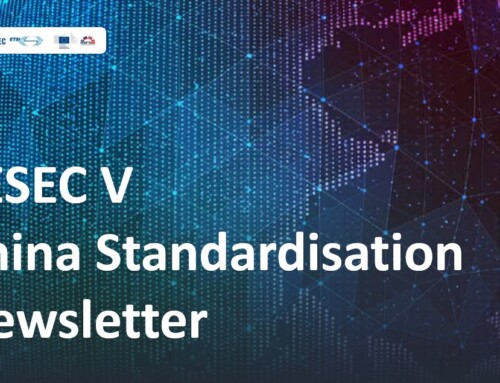China has unveiled a comprehensive action plan for its national informatization standards system on 29 May 2024, set to reshape the landscape of information technology and digital infrastructure in the following three years. Titled as “Action plan for developing informatization standards (2024-2027)”, this ambitious plan aims to enhance the nation’s capabilities in driving high-quality development through improved standards in information technology and digital infrastructure, supporting the nation’s strategic goals of establishing a “cyber-power”.
The plan proposes that, by 2027, a number of high-quality informatization standards will be released, and a professional, vocational, and internationalized team of standardization talents will be formed; the quality of standards will be significantly improved, and the effectiveness of implementation will be markedly enhanced; the role of informatization standards in leading technological innovation and driving economic and social development will be fully realized, and their contribution and influence on international standards will be significantly increased.
To realize these targets, the plan highlights the following key tasks.
- Improving the standards system: annual key points for informatization standards work will be formulated, with the focus on the implementation of major national informatization development strategic plans. The work priorities of relevant informatization standardization technical committees will be clarified, and the informatization standards system framework will be researched and released. The list of key standards in the informatization field will be continuously updated and improved, promoting the coordination and alignment of general information technology standards with informatization application standards across various industries and sectors.
- Improving the management system: (the state) will establish a robust mechanism for coordinating and resolving major disputes in the formulation and implementation of informatization standards, removing field limitations, and avoiding issues such as duplicate standard projects, gaps in standards, content overlap, and inconsistent metrics. (the state) will also strengthen guidance and supervision of informatization standards work for departments, industries, localities, associations, and enterprises, encourage standard innovation, and further emphasize the important role of the market in the formulation and implementation of informatization standards. Additionally, (the state) will promote the conversion of advanced and applicable association standards and enterprise standards into national standards.
- Strengthen standards application. (China will) establish and improve the mechanism for citing standards in regulations, increasing the efforts of developing supporting standards for policy implementation and actively applying relevant informatization standards when drafting and revising regulations and policy documents. (China will) promote the deep implementation and application of informatization standards in activities such as certification, inspection, government procurement, bidding, and project cost management. Furthermore, (China will) advance macroeconomic regulation, industrial promotion, industry management, market access, and quality supervision based on standards.
- Focus on key areas. The key areas include key IT technologies such as AI, blockchain, cloud computing, quantum information, digital infrastructure, data resource, industrial digitization, e-government, smart cities and digital villages, digital culture, and green development.
- Facilitate international cooperation. The plan underscores China’s commitment to deepen standardization international cooperation, active participation in international standardization efforts, as well as facilitation of coordinated development of domestic and international standards.
- Enhance basic capability. The plan stresses the government will strengthen the coordination between industry application standards and general technical standards for informatization, and support qualified social organizations in developing advanced and leading association standards. In terms of standardization education, the plan proposes to deepen the construction of standardization courses and encourage universities and vocational schools to offer courses related to standardization, accelerating the cultivation of knowledgeable, technical, and innovative talent. In terms of standards digitalization, the plan requires (relevant technical organizations) to i) conduct foundational research on the theories and methods of standards digitization, establish a comprehensive system for the digital expression and application of standards; ii) make breakthrough on key technologies such as machine-readable standards, open-source standards, and the digital validation of standards; iii) accelerate the structural and digital transformation of existing standards.
To ensure effective implementation, the plan calls for coordinated efforts among various government departments, industry associations, and standardization bodies. It includes provisions for policy support, funding, and public awareness campaigns to promote the development and application of informatization standards.
Overall, this plan is similar to other standardization policy documents, aiming to develop advanced technology standards and contribute Chinese “solutions and wisdoms”to international platforms. However, some of the proposed measures remain controversial and uncertain. For example, the plan suggests promoting the deep implementation and application of informatization standards in activities such as certification, inspection, government procurement, bidding, and project cost management, which may create potential market barriers. The plan also proposes converting advanced and applicable association standards, and even enterprise standards, into national standards, which could further increase the compliance burden on businesses. The plan supports Chinese enterprises, cooperative platforms, and social organizations in participating in the development of international standards, and aims to convert Chinese advanced technologies and standards into international standards. How this will be achieved in the current context where channels for participating in international standardization are controlled by government-led standardization organizations remains to be seen. The plan suggests promoting the simultaneous development of patents and international standards, which may imply that China intends to embed patents into international standards, potentially leading to trade disputes.
As China advances its informatization standards system, the global landscape will experience increased collaboration and competition. This will drive innovation on one hand and reshape the current standardization landscape on the other.
The translation of the document can be downloaded Annex 3 – SESEC Translation Action plan for developing informatization standards (2024-2027)




